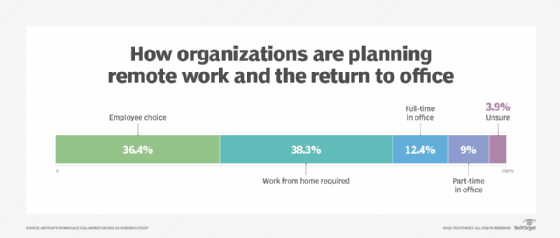
Getty Images
Hybrid work strategies fuel Enterprise Connect 2021 topics
Navigating the post-pandemic workplace is challenging. Enterprise Connect 2021 will explore UC's role in supporting ongoing remote work and the hybrid workplace.
For much of 2020, organizations were in preservation mode, quickly deploying unified communications and collaboration tools to mitigate the business disruption caused by the pandemic. Now, organizations are reevaluating their UC investments as they plan for ongoing remote work and a possible return to office environments.
At Enterprise Connect 2021, which takes place Sept. 27 to 29 virtually, attendees will likely seek advice on how to use UC technology to navigate the challenges of long-term remote work and hybrid office setups.
In this Q&A, Metrigy analyst Irwin Lazar highlights some key trends to expect at the conference that will help IT leaders and decision-makers shape their UC buying priorities in an uncertain future.
Editor's note: The following interview was edited for length and clarity.
What trends will drive the conversation at Enterprise Connect 2021?
Irwin Lazar: A couple topics are going to stand out. First is how you ensure an equal experience, or meeting equity, in the office and at home. We're now going back to an environment where in-office people can't fully participate in a meeting. For example, people in a meeting room may not have access to a virtual whiteboard app. You can sketch on your monitor at home, but how do you contribute in a meeting room? Do you have to log in to a laptop to access the whiteboard?
Also, thinking about what technology vendors have demonstrated to allow people to be in a [video conferencing] box, regardless of whether they're in a meeting room or at a desk. Some are using multiple cameras to capture images to ensure an equal experience, regardless of where you're working.
Another is ensuring employee engagement -- managing video burnout, managing remote employees, making sure they are part of a team and culture. Organizations are focused on the hybrid workplace, improving experience through better quality video and audio, and improving the ability for IT to manage remote workers.
How have UC priorities changed over the last year?
Lazar: I think a lot goes back to the idea of many different apps came into the workplace in the last year and a half. Now, the focus is finding the right mix and improving the quality of the user experience. The biggest issue I've seen enterprises dealing with is the security and management of remote workers and how to proactively understand if someone at home is having poor-quality voice or video.
I've seen survey data that says 30% of employees have voice and video quality issues at home, and that's consistent with what we've seen with things like network-related issues outside of IT's control, background noise and poor cameras.
Technology to improve the home worker quality of experience is continuing to come out. We saw a lot of product launches in the last six months; I expect to see more coming up designed to help companies better provide the right tools to manage remote workers. In our research, we've seen companies really struggle with what to give people at home, how to pick the right headset, if workers need a better camera or speakerphone, and other configuration challenges.
How are organizations planning for 2022?
Lazar: In 2022, the big unknown is: Do we go back to the office? It seemed like we were all planning on that in May as we started vaccinations, and then the Delta variant threw a wrench in those plans.
What will drive a lot of discussion are questions around what the ideal office environment is, what devices and equipment are needed in meeting spaces, how to manage people in terms of not forcing those who work well at home to come back to the office.

The big areas we expect to explode next year are employee engagement and employee experience management. There are dozens of companies in this space that do things like surveying employees, monitoring health, employee wellness, and participation in social and team collaboration apps.
One session I'm doing [at Enterprise Connect] is about what's beyond team collaboration and video -- the evolution of collaboration. A big theme for us is who should own employee experience: HR or IT? Also, how to measure experience and ensure employees are engaged.
What are you most interested in seeing at Enterprise Connect 2021?
Lazar: I think it's going to be a cool evolution in improving the home experience and addressing the challenges of work from home from a hardware, quality and management perspective. We're seeing a lot of advancements in noise cancellation over the last year and improved presentation skills. The biggest area that I would expect to see some announcements is going to be on the hardware and software side to blend office and home collaboration.
The evolution of meeting application vendors to go after the events market has been interesting. Zoom, Cisco and Microsoft have made strong pushes to support events. I expect we'll see some more enhancements there.
Enterprise Connect is really good at grounding an audience. All we want to talk about is the future, but the day-to-day person who's responsible for UC still cares about management, security, operational issues, [Session Initiation Protocol] trunking. It's more of a tactical conference; it's important not to lose sight of that.







